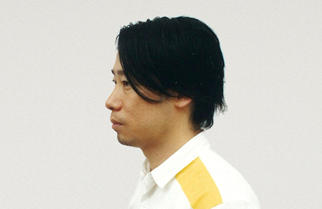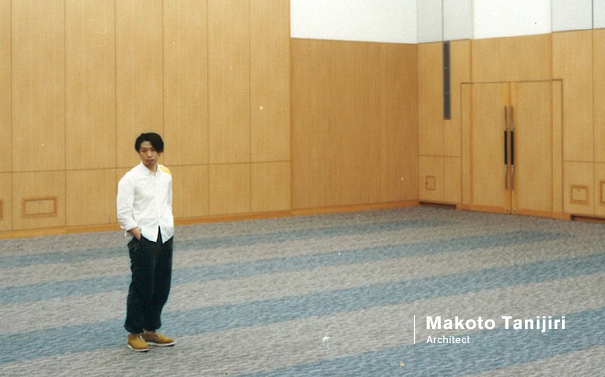
05 Makoto Tanijiri (Architect)
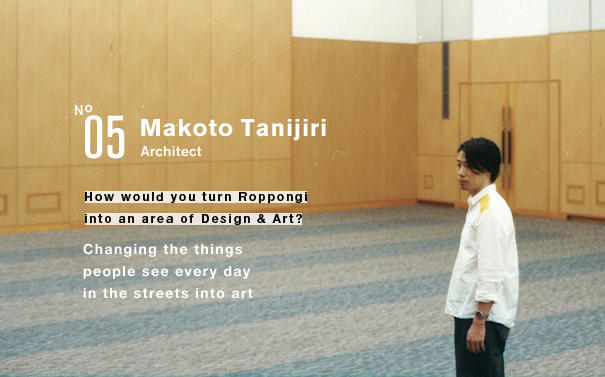
- JP / EN
Makoto Tanijiri is an architect whose works span a wide range from housing and commercial facilities to venues for exhibitions. Tanijiri told us that the venue design he undertook for the "DESIGNTIDE TOKYO" in 2008 and 2009 helped boost his career, leading him to be busy not only in his headquarters in Hiroshima but in Tokyo and abroad. The Tokyo Midtown Hall was the venue for the event. Revisiting the place that opened the door to new opportunities, Tanijiri looked around him as if reminiscing, and then talked about his thoughts on the future of Roppongi.
Changing what already exists into art
To turn Roppongi into an area of design and art on an everyday basis, and not just for limited time periods, I would change what already exists into art. There is the notion that you need to visit museums and such places in order to look at art, but I think it would be more interesting if you are walking along the street and what you glance at happens to be art.
You suddenly notice that there is a work of art over here, and over there, and the numbers keep increasing, and you see that the works are all connected. Then your perspective begins to change. You start looking for the next piece of art, and you begin using your senses in a different way. I think art fundamentally has the effect of shifting people's perspectives and senses. A good way of transforming Roppongi would be to give a totally different appearance to the things that people see every day such as the traffic lights and multiple-tenant buildings.
Waterfalls on the crosswalks, clothes on the buildings
To give a specific example, something could be done with the pedestrian crosswalks. When people walk across, perhaps waterfalls could suddenly appear on both sides. You would walk over to the other side feeling like Moses who has just parted the sea. (laughs) Traffic lights need not be the only way to temporary halt the cars to let people cross. When you realize that, you see that all kinds of ideas are possible.
Putting clothes on buildings is another thing I have long wanted to do. When you put a lace tablecloth on an old table, the table is changed into something new. In a similar way, if you put a lace dress on an old building, new value is given, making the building a work of art. Painting the walls of a building takes many days and requires scaffolding, but in dressing a building, you could make the clothes in another place, and the buildings could easily be undressed. At the "DESIGNTIDE TOKYO 2008", I made works on the theme of "architecture made of cloth". Japan leads the world in fabric technology, and I feel there must be more interesting ways to utilize that technology.
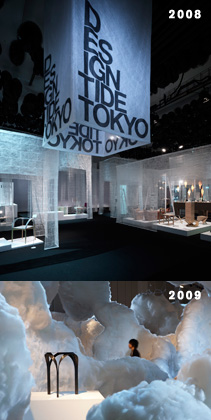
DESIGNTIDE TOKYO
This exhibition showcases the work of creators from many kinds of genres such as interior design, product design, architecture, graphic design, textiles and fashion. The pictures are of the DESIGNTIDE TOKYO in 2008 and 2009 whose venues were designed by Tanijiri. (Venue: Tokyo Midtown Hall)
A Ritz-Carlton room as an art gallery?
As for a limited-period event to promote Roppongi as an area of design and art, my proposal would be to turn the rooms at the Ritz-Carlton, Tokyo in Tokyo Midtown into art galleries. Hotel rooms are usually empty in the day time, so the rooms could hold artworks and be opened to the public during the day as small galleries. People don't often get the opportunity to enter the Ritz-Carlton, but they would find it easier to visit if there was a gallery inside. And the guests staying there would be able to spend a longer time appreciating the art in their rooms.
By putting pictures on the walls, a hotel room could be called a gallery, but the situation becomes ambiguous so that you don't whether it's a hotel or a gallery, or whether it's both at the same time. I think it's okay to have that kind of situation. The works of art don't have to be limited to pictures on the wall, but could also be the bed or the bedding. That kind of situation would be fun in itself, don't you think?

The feeling of strangeness helps shift perspectives
Making people experience a feeling of strangeness is important. I think that triggering the feeling of discomfort in a good way is particularly important in art. We live our lives based on common sense and acquired assumptions. For example, if you look at a PET bottle filled with water, you can imagine how heavy it would be. There is common knowledge of how heavy such things usually are. But if you picked up the bottle and it was really light, your hand would unconsciously go up because it wasn't as heavy as you expected it to be. Conversely, if it were much heavier than you thought, you would be surprised and your hand would go lower. There would be a feeling of strangeness. The feeling of discomfort arises when people have an assumption of what is normal. That discomfort surprises us, and helps us change the way we look at things.
When something extraordinary happens, people won't be able to perceive that it is extraordinary unless they have commonly-held assumptions. So there first needs to be recognition of what is considered normal. Then we are made to rethink our assumptions and that, to me, is the most interesting and meaningful aspect of art.
Creating things by asking the right questions
Rethinking our acquired assumptions is also my approach toward architecture. In designing, I set out by first questioning what people say and think to be the norm. I might ask myself why a room is a called a living room. I keep on asking such questions like "What are the factors that define a living room?" And as I continue wondering to myself, I end up designing a living room in an unexpected place.
Quite simply, there is freshness in finding uses for things other than the usual way. It becomes even more exciting when there is a very unconventional element. For example, a live performance in a "sento" (Japanese communal bath house) is something that I would be interested in. If someone asked me to build a music club, I would probably end up building a facility fit to be called a music club. But with someone singing, a mere bathtub can become a music club. So the question to ask would be, "What are the factors that define a music club?" And if we kept on asking the right questions, it would be possible to build a completenew sort of music club that didn't exist before.
The THINK activities in Hiroshima
On the floor above my office in Hiroshima, I had a gallery space built, and last year I started activities there called "THINK", doing things like holding talk events and setting up a one-night-only pub. It's an experimental place to discover what the defining factors of things are. To my mind, discovering them is essential to design.
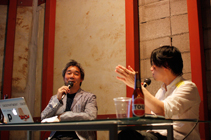
THINK
The "THINK"-activities hold at Tanijiri's office including talk events with invited guest speakers and other events related to a guest of month. It is a monthly event hold in Hiroshima where less numbers of exhibitions or talk events are hold compared to Tokyo, and creators playing an active role at home and abroad are invited to talk about their activities, sources of ideas together with the backgrounds of their creations.
Last year in Shizuokua, I was involved in renovating a Japanese-style bar into a café. I really thought hard about what the defining factors of a Japanese-style bar and a café are. Then I started the renovation and realized that not everything about the building needed to be changed. It was possible to make a very different kind of space just by using the bar in a different way, or having certain items in place. Some important elements of the bar's interior and operations were extracted, sorted out and put back, and that was enough to create a very new kind of space.
I think the area of Roppongi could change in a similar way. The buildings could stay as they are now, but the area would change considerably by extracting the attractive elements of the activities here, sorting them out and putting them back where they belong.

The activities of people are more important than the things in a town.
I grew up in a town called Miyoshi which is about an hour's drive from the center of Hiroshima. There is a riverbed right near our house, and after school club activities, I would go to the river carrying a fishing rod. I would prop up the rod in a heap of stones and then I'd just daydream. When the sun started setting, I would put a bell on the tip of the rod and when it jingled, I would go home. That was the way I spent my days. So I rather like towns that have rivers.
But it's not rivers or those things that really matter. I think the appeal of a town has a lot to do with the people you meet and the food you eat there. I'm an architect, but the architectural aspects of a town do not make me want to visit it frequently. It's more natural, don't you think, to want to go to a town because you wish to meet the people there. The activities of people are more important than the things in a town.
The welcome from the people is the biggest appeal
I think basically, the best thing about any town is the welcome you get from its people. The thing that will draw you most is nice people saying, "Welcome to our town!"
My work was initially based in Hiroshima, so I didn't know Tokyo very well, and I had this image of Roppongi as being a glittery place. I thought that it was an inaccessible area full of shops for the wealthy. But when I actually came here, there were shops that even I could casually walk into, and I learnt from long-time residents about the various interesting establishments. The people in Roppongi take the place for granted, but for people from elsewhere who are new to it all, it's fascinating. I still hope to learn more about Roppongi from the people here.
My biggest interest is people. They let me go beyond myself
As an architect, my biggest interest is people. When you've done a certain number of projects, you begin to see your own capabilities; as long as you are keeping the work within your control, you can get a rough idea of what kind of steps will lead to what kind of results. And when you get to that stage, it's difficult to get excited by what you make. I don't like feeling that way. I want to be always excited by what I have created.
I suppose I'm interested in people because I'm seeking to go beyond myself. When I meet people, there's a chemical reaction, and I become aware of possibilities I never even thought of before, or I get ideas that grow in unexpected directions. By exchanging thoughts with many different people, my work becomes bigger than myself.
I have this conviction that there must be more we could do, and that we should always be searching for ways for improvement. People other than myself matter to me because they have qualities that I do not, and they bring new possibilities in creating things.
Editor's thoughts
Tanijiri-san suggested ideas such as putting clothes on buildings and installing waterfalls on pedestrian crosswalks- steps which would no doubt make Roppongi world-famous. I was particularly impressed by his comments on the need to question our acquired assumptions. It made me think about how our imagination is limitless. It even made me wonder what this Roppongi Future Talks website would look like if we tried to express ourselves without using words. (edit_rhino)




